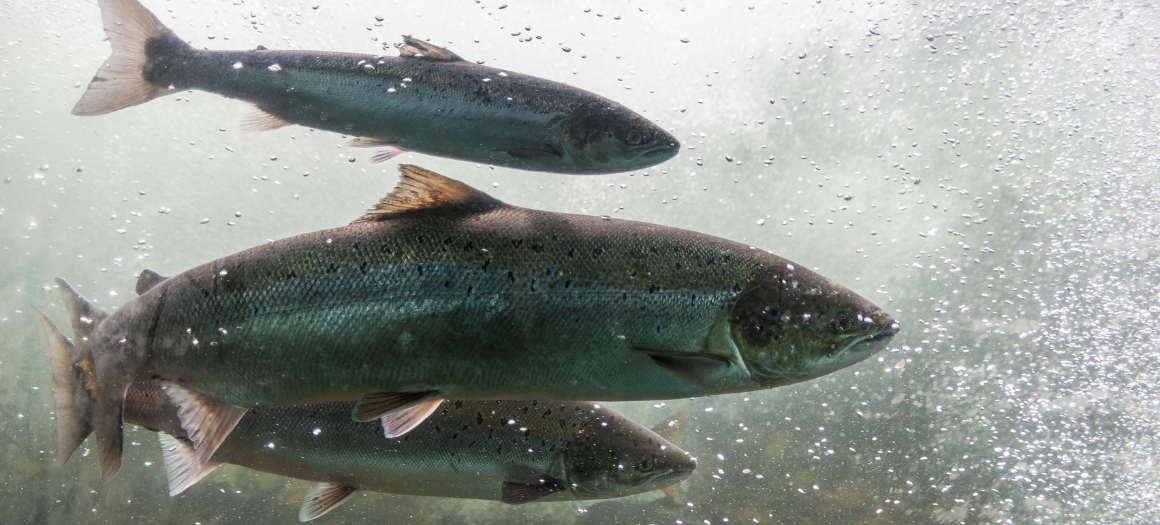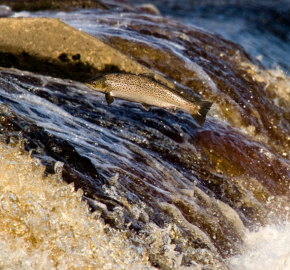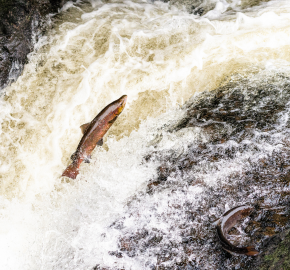Uncovering population declines of Atlantic salmon on both sides of the channel

Detailed study of Atlantic salmon shows that population declines seen in UK rivers are mirrored in France. Perhaps unsurprisingly populations appear to be experiencing very similar pressures.
The SAlmonid MAanagment Round the CHannel (SAMARCH) project – of which WildFish is a partner – has uncovered significant scientific findings to support this trend. The results of these developments – into the scientific study and management of Atlantic salmon and sea trout – were presented to over 100 delegates at a recent conference in Brittany.
Work has been primarily undertaken through studying the populations of Atlantic salmon and sea-trout on the rivers Tamar, Frome, Bresle, Selune and Scorff.
The conference proceedings present a strong case for political support of migratory fish, and their importance to local communities and future generations. That said, there is much more to do to ensure the improved survival of salmonids throughout their migratory journeys on both sides of the channel.
The factors that impact migratory fish
1. Commercial fishing activities
In France, they have made good headway in understanding the risk of capture from commercial fishing activities targeting other species.
Higher risk areas have been identified and further protection is being considered both inside and outside the marine protected area network. Atlantic salmon, sea trout and other diadromous fish such as Allis shad and sea lamprey are listed sensitive species requiring protection in the marine environment of each countries fishing waters.
2. Barriers to migration
Barriers to migration were an important focus. Delegates considered the resulting impact of habitat connectivity and restricted fish passage.
Impacts from hydropower, suspected high levels of cormorant predation, high sediment loading and agricultural diffuse pollution, as well as recent outbreaks in Brittany of suspected UDN in spring running salmon are also areas for concern.
Solutions to protect migratory wild fish
Whilst the key focus of the project is to further understand the behaviour of salmonids in estuarine and coastal waters and to develop management advice to address marine stressors affecting survival. Two very different methods have been adopted by SAMARCH partners to help prevent the decline of Atlantic salmon and sea-trout on both sides of the Channel.
1. UK: catch and release
The UK have adopted a catch and release principle while salmonid populations are under extreme pressure, ensuring enough adults survive to spawn. Catch and release is well accepted as a management method to protect stocks.
The current focus is not really whether to do it, but how to carry it out as effectively and safely as possible. The aim is to ensure the best chances of survival for all fish to go on to spawn. The main risks that need to be carefully considered and reduced, include:
- Not fishing during heatwaves, if the water temperature is above 19 degrees Centigrade.
- Using smaller barbless hooks with the least risk to the fish (in many cases single hooks will be best).
- Keeping the fish in the water.
- Allowing the fish to fully recover with minimal and careful handling.
- Always wetting your hands when handling the fish.
2. France: closure of river fisheries when Total Allowable Catch is reached
In France a river fishery is closed when the Total Allowable Catch is reached. For many in France, the fishing season has now become extremely limited.
Our full summary of the SAMARCH 2022 International Forum is avaliable to read below.
read now




Surely the predation by otters and meganza ducks etc, where these species are uncontrolled is very detremental to the smolts in some rivers . As things are at the moment an inverted pyramid is being created with not enough prey and to many predictors,and also the fish farms on the West Coast of Scotland are also detrimental because of the sites being near to rivers and creating a high level of sea lice infestation..